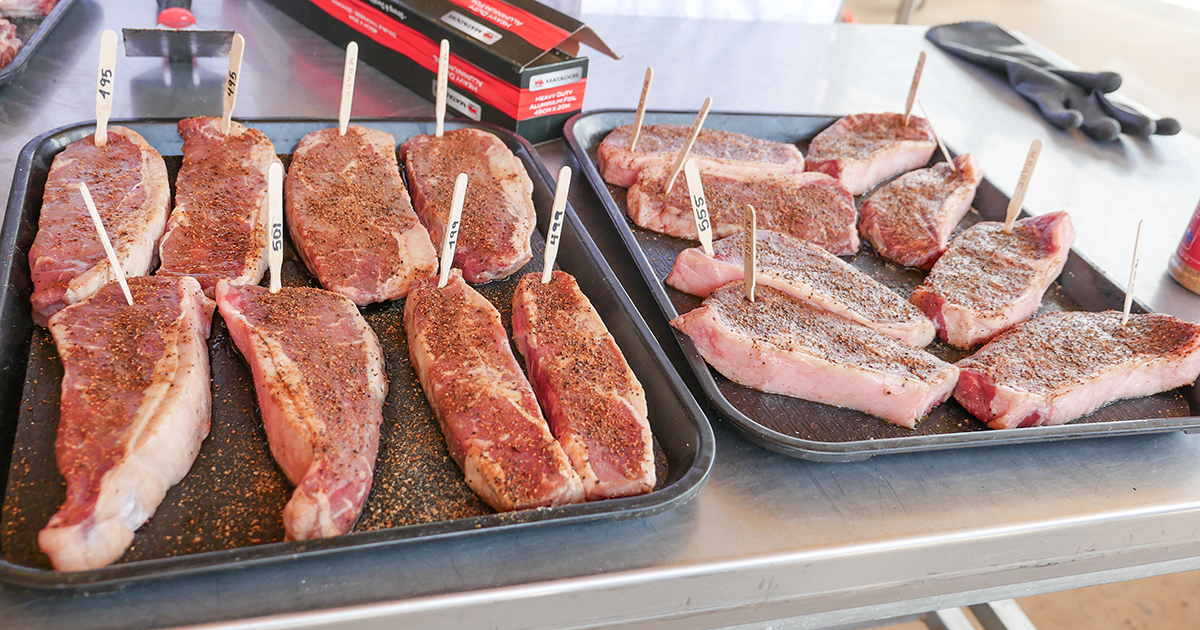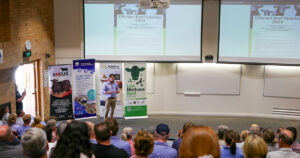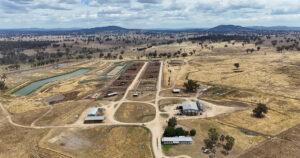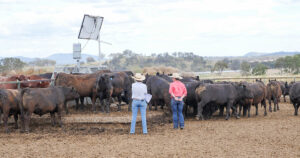What went down at the 2024 Efficient Beef Open Day


The Efficient Beef Open Day held in November, was a showcase of the most recent milestones of a number of ongoing research projects relevant to Angus Australia members and Angus producers.
Taking place at the JP Belshaw Lecture Theater at the University of New England (UNE), Armidale, NSW, and cohosted by UNE and the New South Wales Department of Primary Industries and Regional Development, the Efficient Beef Open Day allowed members and producers to catch up on the research and development being undertaken covering mature cow efficiency, menthane challenges and opportunities and insights on the Southern Multibreed project.
A group of informative presentations took place during the day by research and development specialists from a number of the collaborating organisations.
The current state of global efficient beef research with Professor Sam Clark

Professor Sam Clark, UNE, gave the opening address on the current state of global efficient beef research, with an introduction acknowledging the event sponsors and project partners, including Angus Australia, Meat & Livestock Australia, the NSW Department of Primary Industries, and others.
He highlighted that there are two main ways of managing emissions being indirect selection, classed as optimising the breeding program, through the means of various considerations such as feed additives or other things we can apply to the animal, or direct recording and selection for our breeding programs.
He outlined the carbon cycle’s natural processes and explained how cattle play a crucial role in converting inedible cellulose into nutritious food. Sam highlighted a systems-based approach, balancing soil health, pasture management, feed additives, and genetic improvements. He explained the cumulative benefits of genetic progress in reducing methane emissions, projecting a potential 5–10 megaton reduction in CO2 equivalents by 2040.
Mature cow traits and efficiency with Dr Malshani Samaraweer
Dr Malshani Samaraweer of Angus Australia gave an update on mature cow traits and efficiency. To summarise her presentation, Malshani highlighted that mature cow traits are moderately heritable and that genetic correlations between mature body condition and live-animal ultrasound scan or carcass fat depth (P8 fat and rib fat) traits were low to moderate.
Furthermore, she said that if selection decisions for Mature Cow Body Condition were made based on these fat-depth traits, the genetic progress for Mature Cow Body Condition could be slow, therefore, collecting Mature Cow Body Condition as a direct measure would be easy and cost effective rather than measuring scan fat-depth in mature cows.
Genetic evaluation analysis of methane with Dr Mette Madsen
Research fellow Dr Mette Madsen provided insights into the early-stage data from feedlot trials focused on methane emissions. She detailed the process of collecting, cleaning, and analysing data from over 1,750 animals in 2024, including adjusting for time-of-day methane fluctuations. Mette explained the development of traits like methane production, methane intensity (emissions per unit of output), and methane yield (emissions per unit of input). Initial results showed decent heritability for these traits, and she emphasized the importance of further data collection to strengthen these findings. After discussion the relation of these traits to production traits in cattle, she also identified that sires can be found with good breeding values for both methane and production traits.
Challenges of recording methane with Dr Tom Granleese
Dr Tom Granleese, NSW DPI, discussed the challenges and successes of measuring methane emissions on pasture, a more complex environment than feedlots. Using GreenFeed machines, cattle were trained to voluntarily interact with the equipment to measure methane output. Tom highlighted behavioural differences between breeds, with Angus cattle showing strong adaptability. He also discussed the variability introduced by diverse pasture conditions and ongoing efforts to correlate methane measurements across feedlot and pasture environments.
Initial insights into Southern Multibreed Project analysis with Dr Brad Walmsley
Dr Brad Walmsley, Animal Genetics and Breeding Unit, presented updates on the Southern Multibreed Project, which evaluates six key beef breeds, including Angus. The project focuses on building multi-breed genetic evaluations to enhance beef industry sustainability and efficiency. Brad shared insights into birth weight data, highlighting significant variation across breeds, sites, and management systems. He stressed the project’s success in creating robust datasets to support future genetic evaluations and its role in addressing evolving consumer demands for sustainable and nutritious beef.
Following the presentations, the UNE meat science team, headed by Dr Pete McGilchrist, cooked attendees a steak lunch, using meat sourced from animals from the Southern Multibreed Project. Diners were able to find the data collected from the animal and steak they were served, relating their eating experience to the research being undertaken in the project.


Following the conclusion of the groups time at UNE, they continued the day out at the UNE SMART Farm Tullimba Research Feedlot, where they were able to inspect the Angus Sire Benchmarking Program Cohort 13 and Southern Multibreed steers currently inducted in the feedlot.
– Cheyne Twist, Senior Marketing & Communications Officer